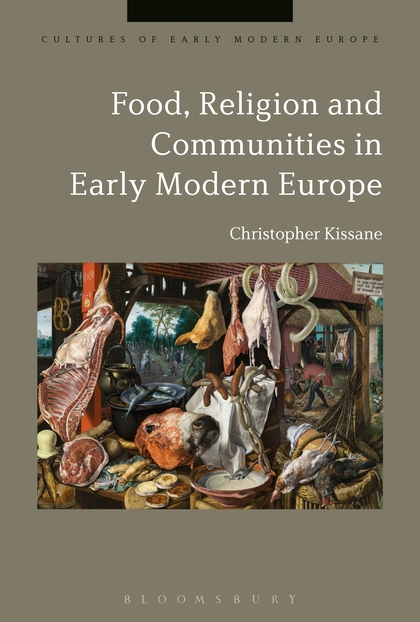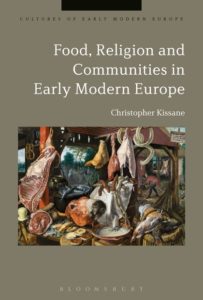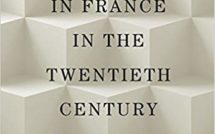

Christopher Kissane has written an engaging and informative book that introduces readers to the significant role of food in the social and cultural history of early modern Europe. He paints a broad picture of a range of communities, from Catholic to Protestant, northern to southern, elite to poor. These patterns are illustrated and enriched by the narration of numerous individual experiences of ordinary people whose food practices came into conflict with religious or secular authorities, and therefore left a paper trail. Food, Religion and Communities in Early Modern Europe is part of the Cultures of Early Modern Europe series at Bloomsbury, a press that has led the way in recent food history publications, with its six-volume Cultural History of Food (2012), Paul Lloyd’s Food and Identity in England, 1540-1640: Eating to Impress (2016), and Sara Pennell’s Birth of the English Kitchen 1600-1850 (2016). Kissane’s volume exemplifies this humanities-centered direction in food history, highlighting the relationship between food and people’s lived experiences. Kissane defends food history as a field in its own right, but also argues for the usefulness of “thinking with food” and using it to understand everyday habits, identities, and communities in early modern Europe.
Kissane argues that food worked as a powerful mechanism to express conformity and deviance. He selects three communities that illustrate this process: Castile in the early sixteenth century, Zurich in the early years of the Reformation, and Shetland a century later, during the age of witchcraft trials. In the first case, Inquisition records from Castile show how attentive Christians were to the everyday practice of religion, and what they perceived as threats to this practice—in particular, the possibility of neighbors secretly maintaining Jewish customs. Food was a visible marker of religious identity, given the importance of fasting in both Jewish and Christian traditions and the dietary restrictions that were part of Judaism. Concerns about food therefore appeared as one of the most common subjects in confessions and evidence provided to investigators. For example, in the village of Almazán, over only a four-year period in the early 1500s, Kissane notes over forty Inquisition documents that included accusations of avoiding or refusing bacon. Neighbors were acutely suspicious of practices such as the preparation of food on Fridays to avoid cooking on the Jewish Sabbath, the use of olive oil rather than lard, and the maintenance of separate sets of utensils in the kitchen. While Inquisition records were oriented towards identifying inappropriate religious practice, Kissane uses them to suggest additional themes, such as the role that women played in maintaining family and community life and the ways in which Christian and converso communities closely interacted with one another.
In the second section, Kissane takes us to Zurich in the 1520s, where the religious concerns of the community were oriented towards conflicts over Lenten fasts. While we usually think of the Swiss Reformation in terms of its debates over issues such as clerical celibacy and the nature of the Eucharist, Kissane draws our attention to a series of occasions in which residents of Zurich deliberately ate meat, dairy, or eggs in violation of the rules of Lent. These actions, according to the participants, were in defiance of regulations that were not based on scripture, though they were also based on practical secular concerns, such as the high price of fish and the difficulty of obtaining oil to use instead of butter. The incidents culminated in a deliberately provocative sausage-eating incident in a church, creating a wedge between Zwingli (who supported the fast-breakers), the local bishop, and the city council. Kissane unpacks the political, theological, social, and economic significance of this conflict and shows how concerns over the interpretation and authority of scripture were inseparable from the lived elements of Christianity and the practical elements of food. Unlike the Inquisition and witchcraft cases where the key actors were women, all the participants in these fast-breaking incidents were men. Kissane does not directly address this gender difference, though he dedicates the next chapter to the cultural symbolism of fast-breaking foods, most of which was masculine: meat, sausage, and butchery were associated with violence and warfare in early modern fables and parables. While other prohibited foods, such as cheese and eggs, were culturally coded as feminine, they did not play as visible a role in the Zurich conflicts.
In the final setting, the small and out-of-the-way islands of Shetland, court records show how beliefs about witchcraft and demonology were closely connected to the production, preparation, and consumption of food. Witches were often represented as inversions of ideal women, so they were associated with threats to milk, fertility, and food supplies. Dairy production was a significant part of the northern European economy, so Kissane provides an extensive discussion of milk magic, with which witches were able to supernaturally appropriate their neighbors’ supplies of milk and butter. The threat of this magic lay not so much in its use of supernatural power as in its similarity to simple theft, and Kissane shows that fears of witchcraft were closely connected to practical concerns about food distribution, competition over resources, and black-market trading. Kissane is careful to address patterns of witchcraft beliefs across Europe, and he uses the Shetland case study (though it provides only thirteen detailed trials) as a blend of Scottish law and Scandinavian custom, and as a region whose economy was centered almost entirely on the production of food (sheep-farming, dairying and fishing). These cases provide ample evidence of the importance of food and its symbolism to early modern demonology, as well as the extent to which early modern communities were concerned about food security.
Taken together, these studies reveal the ways in which early modern Europeans experienced a period of significant religious tension: the incorporation of former Jews into a predominantly Catholic society in Spain, negotiations over religious authority and practice in Reformation Zurich, and fears of witchcraft in seventeenth-century Shetland. There are implicit power relationships in all of these cases, since nearly all of the available evidence comes from the records of authorities responding to activities that defied secular or religious law. Kissane does not, however, frame these conflicts as the imposition of elite authority over popular culture. These stories are about neighbors negotiating the rules of their own communities: servants observing their masters’ culinary habits, carpenters and workmen sharing prohibited sausages during Lent, families quarreling over the profits from milk and butter. These tensions arose from moments of significant change in religious authority and custom in the sixteenth and seventeenth centuries. Kissane’s purpose is not to analyze the cause of these changes, or their effects on the beliefs or social frameworks of early modern Europeans. His emphasis instead is on the everyday experiences and concerns of ordinary people in the midst of these moments. For early modern Europeans, food was an expression of religion, family, gender, status, alliance, and conflict, and if historians want to fully understand these issues, they must be attentive to food.
While Kissane uses these three communities as examples, and provides numerous individual stories as illustrations, he situates his themes within their particular local and historical contexts, as well as within the broader patterns of early modern Europe. (The index is surprisingly thin, especially for a work that weaves together so many places and concepts.) He also includes a thoughtful historiographical perspective on how scholars have approached these themes, demonstrating an impressive familiarity with recent work across several subfields and languages. This book emphasizes that food should be a central subject of inquiry, rather than a tangent or an afterthought. Its stories, however, are ultimately about people; its greatest accomplishment is to show how food practices cast light on religion, community, and gender as they were woven into the ordinary daily activities of early modern Europeans. Its readable and engaging style will be of great value in the undergraduate classroom, while its sophistication and scope will appeal to advanced scholars.
Reviewed by Jodi Campbell, Texas Christian University
Food, Religion and Communities in Early Modern Europe
By Christopher Kissane
Publisher: Bloomsbury Academic
Hardcover / 226 + xi pages, 23 b/w illustrations / 2018
ISBN: 978-1350008465
To read more book reviews click here
Published on February 5, 2019.
Click here for our special feature on Food, Food Systems, and Agriculture.




